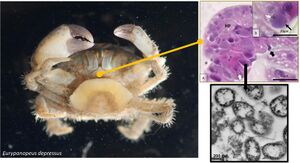Candidatus Mellornella promiscua: Difference between revisions
Tag: Manual revert |
|||
| Line 26: | Line 26: | ||
==Description and Significance== | ==Description and Significance== | ||
Bacterial pathogens such as | Bacterial pathogens such as ''Candidatus'' Mellornella promiscua threaten the survival and fitness of crustaceans. This is threatening the shellfish stock which is a major part of the economy. The cost estimating at $11.5 billion. This shows the importance of studying this species to ensure the economically significant species. ''Candidatus'' Mellornella promiscua inhabits brackish marine environments on the coastline of the eastern United States, specifically North Carolina is where it was found and studied at East Carolina University. It is formally the first identified member of the Anaplasmataceae from a decapod host which is important to study it further and its effect on the crustacean species. | ||
Bojko J., McCoy K., Blakeslee A. 2022 | Bojko J., McCoy K., Blakeslee A. 2022 | ||
Revision as of 01:48, 10 November 2023
Classification
Prokaryota; Proteobacteria; Alphaproteobacteria; Rickettsiales; Anaplasmataceae.
Species
|
NCBI: [1] |
Genus species
Description and Significance
Bacterial pathogens such as Candidatus Mellornella promiscua threaten the survival and fitness of crustaceans. This is threatening the shellfish stock which is a major part of the economy. The cost estimating at $11.5 billion. This shows the importance of studying this species to ensure the economically significant species. Candidatus Mellornella promiscua inhabits brackish marine environments on the coastline of the eastern United States, specifically North Carolina is where it was found and studied at East Carolina University. It is formally the first identified member of the Anaplasmataceae from a decapod host which is important to study it further and its effect on the crustacean species.
Bojko J., McCoy K., Blakeslee A. 2022
Genome Structure
Candidatus Mellornella promiscua has a circular genome about 1,013,119 base pair in length. It encodes 899 protein coding genes, 1 pseudo gene, 3 ncRNA genes, 3 rRNA genes, and 33 tRNA genes. This encodes functional proteins that help with metabolism, synthesis, energy, DNA processing, secretion, translation, signaling, recognition, regulation, structure, motility, resistance, and others. Region I is composed of mix of metabolic and structural proteins. Region II is the largest region, and is composed of two protein groups: nitrogen processing and biosynthesis. Region III is signaling functions.
Bojko J., McCoy K., Blakeslee A. 2022
Cell Structure, Metabolism and Life Cycle
Identification during a transmission electron micrograph showed multiple bacterial vacuoles expanding in the cell cytoplasm. The bacterium typically had vacuolar membrane but in advanced infections they didn't have the vacuolar membrane and directly interacted with the host cell cytoplasm. Most bacterium presented a pill-like structure expanding around the bacteria cell as well as a fibrous inclusion body. Their life cycle consist of binary fission. Region 1 of the genome contains 12 protein coding genes which also consist of metabolic proteins. The bacterium also has multiple semi-conserved biosynthetic secondary metabolite clusters.
Bojko J., McCoy K., Blakeslee A. 2022
Ecology and Pathogenesis
Candidatus Mellornella promiscua is a bacterial pathogen than is found in the fatback mud crab, Eurypanopeus depressus. The mud crab is native to estuaries in the Western Atlantic and Gulf of Mexico; particularly on the North Carolina coastline with a prevalence of 10.8%. It co-infects with rhizocephalan barnacle, Loxothylacus panopaei. It causes cytoplasmic hypertrophy, tubule necrosis, large plaques, and an abundance of sex-pili. It also contains bacterial symbionts that cause disease in different hosts; however, since it is a relatively new identified species it is unknown if it causes mortality in the crab host. It is predicted that it may have a way of altering the host microbiome to benefit its reproduction and growth and utilize the resources supplied by the host.
Bojko J., McCoy K., Blakeslee A. 2022
References
Bojko J., McCoy K., Blakeslee A."Candidatus Mellornella promiscua n.gen.n.sp.(Alphaproteobacteria: Rickettsiales: Anaplasmataceae): An intracytoplasmic, hepatopancreatic, pathogen of the flatback mud crab, Eurypanopeus depressus".Journal of Invertebrate Pathology. 2022. Volume 190. https://doi.org/10.1016/j.jip.2022.107737
Author
Page authored by Maggie West, student of Prof. Bradley Tolar at UNC Wilmington.

